1737 N. Highland Ave. Los Angeles, CA 90028 |
map |
Opened: November 20, 1940 as the Movie Parade Museum of Silent Pictures,
a 16mm silent film revival house. Soon it was just advertised as the Movie Parade. It was later a film/legit venue called the Comoedia Theatre. The location was on the second floor
of a building on the west side of the street less than half a block
north of Hollywood Blvd.
The theatre had been in the darker of the two similar buildings on the left, below the "GO" semaphore in this
c.1950 view north from Hollywood Blvd. By the time of the photo the building had acquired a Gruen watch sign advertising a bar called Highland House. The smaller vertical sign down
lower said "cocktails." It's a photo by Weegee appearing on the
International Center of Photography website. Thanks to Dave Cutter for locating it for a post on the
Photos of Los Angeles private Facebook group.
The
dark-fronted building at 1733-35-37 resembles the lighter
1729-31-31 1/2 building to the left and presumably the two were constructed together. Note the similar facades at this time. The
Sanborn maps indicate that they shared a common wall. Billie's Liquor
Store is on the far left at 1727, its building out of the frame. In the
1956 phone book the white half of the building was Meyers Costume at
1729 and Launder-Ease at 1731 1/2. 1735 was the Highland House /El
Torero restaurant. Upstairs at 1737 didn't get a listing. Beyond was a parking lot
and then the Tropic Super
Market at 1741.
A November 19, 1940 pre-opening ad in the Hollywood Citizen-News located by Ranjit Sindhu. He has researched this venue, as well as many other L.A. revival operations, for a gigantic
Revival Cinemas page on his site about
Buster Keaton's "The General". He includes lists of the films that played the theatre along with links to ads for them via Newspapers.com. Thanks!
The opening bill included Syd Chaplin in the 1925 film "Charley's Aunt" along with Douglas Fairbanks in "The Grinning Gringo," Chaplin in "The Fireman" and Mary Pickford in "Shadows of Doubt." It's unknown who was playing for accompaniment. Thanks to Ranjit for locating this flyer.
The theatre was a commercial venture operated by Eddie Kohn. Ranjit notes that Olga Egorova, a
Russian researcher, helped him piece together the story on Eddie. He was an
agent who had worked at the Bob Goldstein agency and was later employed
under Franklyn Underwood at the 20th Century-Fox scenario
department. Ranjit surmises that the prints used were from Eddie's personal collection. Later there were lawsuits over copyright issues.
The 1729-1737 N. Highland buildings were evidently constructed before 1907. They're seen in pink in this detail from page 5 of the
1907 Sanborn Fire Insurance Map in the Library of Congress collection. Note the earlier address numbering. The street level storefronts in the north building were vacant and there was a Presbyterian Church on the second floor. The map notes that part of that second floor had a ceiling bumped up 7' higher.
The buildings can also be seen on page 9 of the
1913 Sanborn Fire Insurance Map that's in the LOC collection. At that time the tenant at 1733-35-37 was an undertaker, Gates and Crane. Presumably they were using both floors. Also see a
1921 Baist map on the David Rumsey Map Collection site. A 1940 permit for some door work noted the 1733-35-37 building's size as
70' x 80' with a 28' height at its highest point. In the 1963 demo
permit the size was given as just 50' x 50'.
Ranjit notes that by 1930 the upstairs hall was leased by the
Hollywood Humanist Society run by Theodore Curtis Abel, a Unitarian minister. By 1937 it was briefly in use as the
Creative Theatre managed by Karol Morell Waxman.
In 1938 the
L.B. Williams real-estate office used the space to train salesmen. Downstairs had a whole string of tenants including the Aulic Club Café, Edward Tierney’s Place, Consolidated Distillers, Ltd., The Pall Mall and the Hot Spot. In the 1942 city directory it was the El Sombrero Cafe. In the 1956 phone book it was listed as both the El Torero and Highland House.
The building that the Movie Parade had been in at 1733-35-37 N. Highland is indicated in green on this detail from pages 1018/1019 of volume 10 of the Sanborn Fire Insurance Map that Ranjit located in the
Library of Congress collection. They have page 1018 as image 21 out of the 94 from this volume as reproduced on their site.
The Movie Parade building shared a common wall with the building to the south at 1729-1731-1731 1/2. In the
c.1950 Weegee photo the two can be seen with a common facade. The map was originally drawn in 1919 and updated as late as 1950. That's the Hollywood Hotel in the lower left and the 1st National Bank Building in the lower right. If you look at the full page on the LOC site you also get Grauman's Chinese farther to the left.
Philip K. Scheuer gave the new theatre a nice plug in his "Town Called
Hollywood" column that appeared on the "Studios / Theater Gossip" page
of the Sunday, December 1, 1940 L.A. Times:
Thanks to Ranjit Sandhu for locating the item.
A December 16, 1940 item in the Citizen news plus an ad in the same issue for "Behind the Front" and a personal appearance by one of the stars, Raymond Hatton. "Behind the Front" had a seven day run beginning on the 12th. This was located by Ranjit Sandhu for his
Revival Cinemas page. In addition to the Movie Parade and other venues, he discusses the Monday silent movie nights at the Windsor House on Ventura Blvd, a restaurant owned by Bud Abbott, of Abbott and Costello fame.
Wallace Beery's visit to the theatre was noted in Jimmie Fidler's syndicated "Touring In Filmland" column that appeared in the December 19, 1940 issue of the San Pedro News-Pilot. It was spotted by Ranjit.
Ads in the Citizen-News from the week of January 2,
1941 for the
Tele-View Revival (soon to become the Hitching Post) and other Hollywood area
independent theatres. Thanks to Ken McIntyre for locating this for a Facebook post on
Ken's Movie Page. The Movie Parade had "The Hunchback of Notre Dame" along with Harold Lloyd's "Safety Last." The Chaplin film, one of several that would soon provoke a lawsuit, was "A Night in the Show."
"Manhandled" with Gloria Swanson had a seven day run beginning February 1, 1941. That engagement elicited this comment that Ranjit located in the February 28 issue of the Citizen-News.
"The General" with Buster Keaton had a seven day run beginning March 6. Also on the program was "Dancing Mothers" with Clara Bow and "Every Inch a Man" with William S. Hart. Regarding the print they had for "The General," Ranjit comments: "Either it was pirated from the MoMA 16mm which had just begun to circulate a year previously, or it was the 40-minute abridgment that United Artists had created for 16mm film clubs back in 1928 or thereabouts."
Buster showed up for one of the screenings of "The General." Thanks to Ranjit for locating this item that appeared in Louella Parsons' column in the San Francisco Examiner on March 11, 1941.
A matinee on Sunday, March 9 featured a one-off showing of the 1926 film "The Grand Duchess and the Waiter" starring Adolphe Menjou along with Chaplin in "Easy Street." Eddie veered into modern territory with an experimental color short, perhaps one by Oskar Fischinger. Thanks to Ranjit for locating the March 8 Citizen-News item.
One customer wanted his money back after seeing Douglas Fairbanks in "The Americano." Thanks to Ranjit for locating this item in Sidney Skolsky's March 19, 1941 column in the Citizen-News. The film was released in 1916. It had opened April 3 for a twelve day run. Also on the bill were Chaplin in "The Floorwalker," Will Rogers in "Two Covered Wagons," and a Charley Chase short.
This ad that Ranjit located in the June 4, 1941 issue of the L.A. Daily News marked the last day for several months that the Movie Parade name was used at this location. They had opened a "Chaplin Festival" featuring seven of his shorts on May 1. Beginning May 29 the 1925 film "Charley's Aunt" with Syd Chaplin was added to the program.
From June until the end of August 1941 the Movie Parade name moved to a screening room at 1455 Gordon St. for a summer series of silent films on 35mm presented in conjunction with the Academy of Motion Picture Arts and Sciences. See the page about the Gordon St. Movie Parade location.
Also of interest during the summer of 1941 were screenings that Eddie arranged downtown in the 5th floor May Co. space that had once been called the Arrow Theatre. The July 31 event included free showings of Chaplin's "Easy Street" and Mary Pickford in "Shadows of Doubt."
After a month-long break, 16mm screenings resumed at this Highland Ave. location, temporarily renamed the
Nickelodeon. According to Ranjit's research for his
Revival Cinemas page, the first program under the new name was a 27 day run that began July 3, 1941 of "The Hunchback of Notre Dame" and "The Phantom of the Opera."
An August 13, 1941 Nickelodeon ad in the Citizen News for "The Cabinet of Dr. Caligari" that was located by Ranjit Sandhu for his article
Revival Cinemas page.
An August 20, 1941 item in the Citizen-News about the "First Regular Run Locally" of "Dr. Caligari" that was located by Ranjit. The initial L.A. booking for the film had been set for May 7, 1921. The page about
Miller's Theatre on Main St. has stories about the protests organized by the American Legion and the I.A.T.S.E. that stirred up post-war anti-German sentiment and spread tales about the film being propaganda. See a photo located by Scott Collette of
"Dr. Caligari" on the marquee and the mob in front. The initial engagement was cancelled but the film ran at Miller's six months later without incident.
The last show as the Nickelodeon was August 27, 1941 with the theatre still running "The Cabinet of Dr. Caligari." Beginning August 28 it again became the Movie Parade.
An item Ranjit located in the August 28, 1941 Citizen-News.
A September 1941 article in the Hollywood Citizen-News. Thanks to Ken McIntyre for locating this. Ranjit Sandhu notes that "The Bright Shawl" and "Lady of Whims" had a seven day run beginning September 11.
A September 1941 Citizen-News ad located by Ken McIntyre.
Columnist James Francis Crow noted the theatre's 1st Anniversary with this item Ranjit spotted in the November 19, 1941 Hollywood Citizen-News.
Copyright troubles would put an end to the operation, at least for a while. Thanks to Ranjit for locating this Variety article from December 31, 1941.
The trade magazine The Billboard followed up with a longer discussion on the "Roadshow Films" page of their January 24, 1942 issue. Thanks to Ranjit for locating it.
Closing as the Movie Parade: The last day of operation was December 29, 1941. The last program, which had opened Christmas Day, was Fairbanks in "The Americano" along with "Peck's Bad Boy" starring Jackie Coogan.
Thanks to Ranjit Sindhu for the research. See his
Revival Cinemas page for a complete list of titles and dates for the films shown during Eddir Koln's tenure. He notes that Eddie seemed to evaporate without a trace. The "Movie Parade Theater" was still listed in the 1942 city directory.
Reopening: Sometime before August 1944 it became a legitimate theatre operation called the
Comoedia Theatre, operated by René Plaissetty's Hollywood Academy of Drama. Ranjit located a
Wikipedia article about René.
The Comoedia was casting a show and this November 8, 1945 Hollywood Citizen-News ad caught the eye of Jason Vega. Scott Collette had posted it it on his Forgotten Madness LA Instagram as the SAG-AFTRA strike was ending in 2023.
As the Comoedia, the theatre continued to offer programs of silent films. Ranjit Sandhu comments:
"By
the spring of 1946 management was supplementing its income by
presenting adults-only 'educational' sex films. In July 1946 it gave up
on the stage and it seems there was a transfer, for it then specialized
in foreign films doubled with silent films. Those silent films were the
same silent films that others were showing at different venues.... it surely rented the foreign films from various
catalogues, but supplemented the screenings with silents borrowed from a
collector — or two collectors. Who were the collectors? Probably the
guy who ran Old Time Movies [5440 Hollywood Blvd.], followed by the guy
who ran the Old Movies Club [Yucca and Wilcox].
This nebulous ad appeared on July 11, 1946. Thanks to Ranjit for locating this Comoedia Citizen-News ad as well as the others appearing here. Scroll down to the 1946-47 entries on his
Revival Cinemas page for a list of dates and titles from the Comoedia era.
An ad in the August 15, 1946 Citizen-News.
You'd think advertising the 1941 film "Meet John Doe" in the Citizen-News on August 16, 1941 would have resulted in a letter from copyright attorneys for Warner Bros.
"The Only Theatre Always Showing One Sound and One Silent Picture." It's an August 31, 1946 ad from the Citizen-News.
It looks like the theatre was still in the legit business. This "Interviewing pretty girls" ad appeared on October 1.
Running the 1933 Chiliapin film "Don Quixote" plus silent shorts. It's a December 20, 1946 ad in the Citizen-News.
Still in business in 1947. It's an ad that appeared in the Citizen-News on January 29.
The Comoedia's closing as a film house: August 2, 1947 was their last screening. Thanks to Ranjit Sindhu for the research. He notes:
"The Comoedia continued its 16mm series through 2 August 1947. Then, not long afterwards, it switched back to live performances. The Comoedia seems to have shuttered at the end of 1947. Then in 1949 it became Jack Walklin’s Highland Playhouse. After that, I do not know, but what I do know, for certain, is that the entire stretch of buildings on those few blocks was demolished decades ago to make way for monstrous uglitude."
Closing: The date it finally closed as a theatrical venue is unknown.
Status: The building was demolished in 1963. Thanks to Ranjit Sindhu for locating the permit dated October 21. At the time it was owned by the C.E. Toberman Co. The site is now part of the Ovation mall, formerly "Hollywood and Highland."
A c.1915 look north on Highland beyond the Hollywood Hotel. The farthest of the two similar two-story buildings way down there behind the telephone pole -- the one with the lighter facade -- would be used as the Movie Parade decades later. The photo from an unidentified source appears on a page of
Early Hollywood Views from the W&P Associates site.
A
c.1920 look at the territory from the Los Angeles Public Library
collection. That's Highland going up the right side. The photo makes an
appearance on "
A Charming Hostelry: The Hollywood Hotel Story," a KCET page by Hadley Meares. The building the Movie Parade would later be in is in the upper right, the second one in.
A 1939 view east. The brown back of the building the Movie Parade later occupied is on the far left, just above center. The third building in from the left, 1723-25 N. Highland, would be occupied by the
Troupers Club in the 1940s. "Stanley and Livingstone" was at the
Chinese and the
El Capitan was running a production of "The Mikado - In Swing." Thanks to the
Historic Los Angeles Facebook page for sharing this version of the photo.
A c.1945 view of the buildings on Highland between Hollywood Blvd. and Franklin. That's the east side of the Hollywood Hotel building on the left. The hotel was demolished in 1956. Behind the Red Car it's Billie's Liquor Store at 1727, the Movie Parade (if we could see it) was a couple doors farther up at 1737. The Dutch Boy paint store was at 1751.
Thanks to Ken McIntyre for locating the photo for a post on the
Photos of Los Angeles private Facebook group. David Cutter dates this as 1952. Glen Norman notes:
"The streetcar service on Highland (to the Valley) ended in December, 1952. The
trains that ran on Hollywood Boulevard hung on until September, 1954."
A c.1960 view south on Highland toward Hollywood Blvd. The building the theatre was in would have been over on the right, this side of the First Federal building. That building, which went up in 1959, was demolished for construction of the Hollywood and Highland mall. Thanks to Bill Gabel for locating the photo for a post on the Photos of Los Angeles private Facebook group.
The black sign this side of First Federal is the back of the Dutch Boy
sign, for their store at 1751, in the single story building beyond the
sign. On the left, on the northeast corner of Hollywood and Highland, it's the First National Bank Building, a Meyer & Holler design erected in 1928. For a history of that building see Mary Mallory's Daily Mirror article "
First National Building Banks on Hollywood's Future."
An early 60s view from the Richard Wojcik collection. Thanks to Alison Martino for sharing it on her
Vintage Los Angeles Facebook page.
A last look at the Movie Parade building. It's a detail from the left edge of Richard's photo.
A mid-60s look at the north end of the block. Thanks to Kevin Fleming for locating the photo for a post on the private Facebook group
Southern California Nostalgia. He credits the shot to Alison Martino's Vintage Los Angeles page.
The middle of the block in 1978. This shot and the one below are from Paul
Schrader's "
Hardcore" (Columbia Pictures, 1979).
Looking north toward Franklin. George C. Scott is in the gray car, out looking for his missing daughter.
A
look across from Yucca St. with the mall on the left and the Loew's
Hollywood Hotel, formerly a Holiday Inn, on the right. The Movie Parade / Comoedia building was once located
about where the protruding tip of the mall now is, here seen with red
signage for Shoe Palace. Photo: Google Maps - 2021
More information: See our page about the Gordon St. location of The Movie Parade. Also on this site is a page about various 16mm Revival Houses that had opened between 1940 and 1975.
A number of regular 35mm houses occasionally flirted with revival programming in the 40s and 50s. See our pages about the Cinema Theatre on Western near Santa Monica Blvd., the Sunset Theatre on Western near Sunset, the Tele-View Revival/Hitching Post across from the Pantages, and the Admiral/Vine Theatre on Hollywood Blvd. just west of Vine.
For lots of fine research on the Movie Parade as well as other L.A. revival houses in the 1940s and beyond see Ranjit Sandhu's Revival Cinemas page on his site about Buster Keaton's "The General".
The site Cinema Treasures has a page started about the Movie Parade but without much information on it. Visit the "Hollywood and Highland: A Journey Through the Years" page on the website of the Hollywood Partnership.
On the same block: From 1943 until 1948 the Troupers Club was in the building just north of the Hollywood Hotel at 1723 N. Highland.
| back to top | Hollywood Theatres: overview and alphabetical lists | Hollywood Theatres: list by address | Downtown theatres | Westside | Westwood and Brentwood | Along the Coast | [more] Los Angeles movie palaces | L.A. Theatres: main alphabetical list | L.A. Theatres: list by address | theatre history resources | film and theatre tech resources | theatres in movies | LA Theatres on facebook | contact info | welcome and site navigation guide |




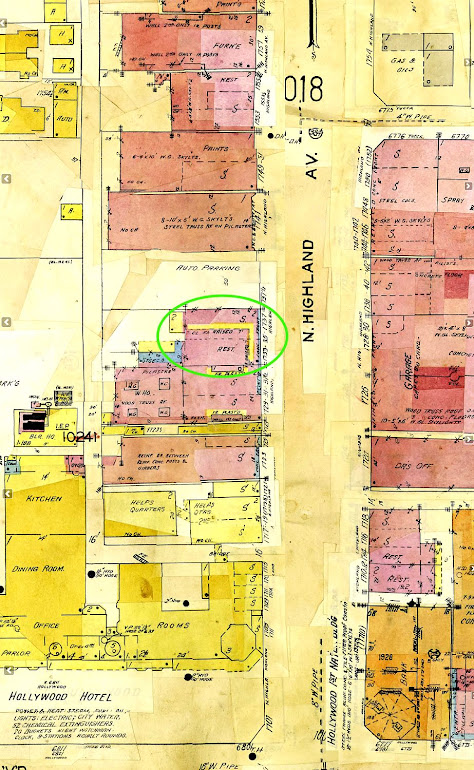



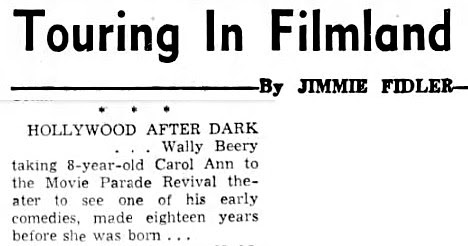
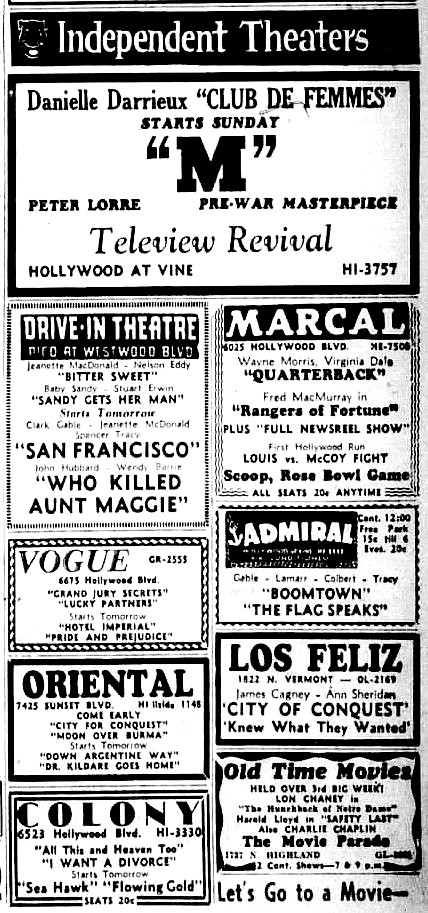











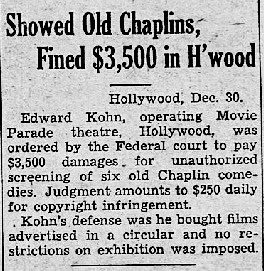









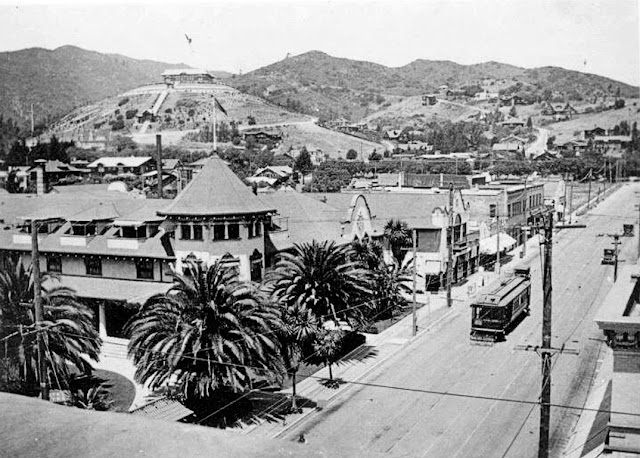











No comments:
Post a Comment